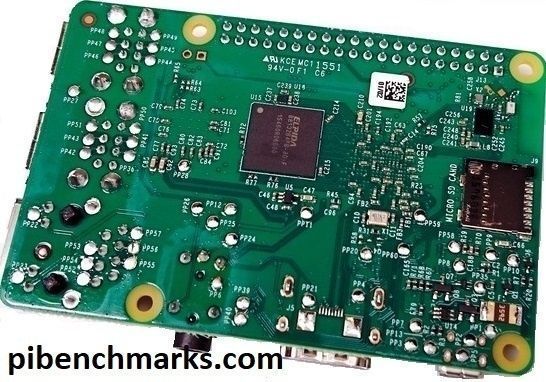
All of the previous generations of Raspberry Pi contained all of their firmware on the SD card. Starting with the Raspberry Pi 4 the device actually has onboard upgradable firmware stored on an EEPROM chip separate from your storage. Updating this firmware is very important as one of the first released updates reduces power usage of the Pi by 30% which also reduces how hot it gets.
In this guide I’ll show you how to update the bootloader firmware (no, it’s not apt-get upgrade, it’s a new utility called rpi-eeprom!) and also show you how to make a recovery SD card if your firmware gets corrupted and needs to be reflashed.
If you are looking for information on how to change the boot order on the Raspberry Pi 4’s new bootloader firmware, check out my New Raspberry Pi 4 Bootloader USB Booting Guide.
Upgrading the Bootloader Firmware
Requirements

The Raspberry Pi 4 is available in different memory configurations all the way up to 8 GB. It’s about the size of a credit card and uses an extremely low amount of power making it ideal for all sorts of projects and ideas!
Links: AliExpress*, Amazon.com*, Amazon.ca*, Amazon.com.au*, Amazon*.co.jp*, Amazon.co.uk*, Amazon.de*, Amazon.es*, Amazon.fr*, Amazon.it*, Amazon.nl*, Amazon.pl*, Amazon.se*, Amazon.sg*

The Raspberry Pi 400 kit includes everything you need for a full Pi 400 desktop build. The Pi 400 is the fastest Raspberry Pi ever released and comes in the form factor of a keyboard!
Links: AliExpress*, Amazon.com*, Amazon.ca*, Amazon.com.au*, Amazon.co.jp*, Amazon.co.uk*, Amazon.de*, Amazon.es*, Amazon.fr*, Amazon.it*, Amazon.nl*, Amazon.pl*, Amazon.se*, Amazon.sg*
To upgrade the firmware you should be running the latest Raspberry Pi OS. Do not attempt this from another distribution. If you want to use another distribution afterward that is great!
Since the Raspberry Pi bootloader firmware is stored on a chip on the device you can update it to the latest with Raspberry Pi OS and then go right back to using whatever you want. I personally have a separate SD card just for Raspberry Pi OS that I use to periodically plug in and update the firmware.
The firmware and the utilities around it are changing so quickly that you are really playing with fire not attempting this with the latest and greatest officially supported distribution when you are talking about firmware / on-board chips / etc.
With that word of caution out of the way, let’s get started!
Install rpi-eeprom (older versions of Raspberry Pi OS / Raspbian)
Newer versions of Raspberry Pi OS come with this utility already but if you are upgrading / have upgraded from an older version you may not have it in some cases. We can install it with the following commands:
sudo apt update sudo apt full-upgrade sudo apt install rpi-eeprom
Once the utility is installed Raspberry Pi OS will check at boot whether there are any critical bootloader firmware updates for your Pi.
Checking for Updates Manually
If you are like me and don’t want to wait around for Raspberry Pi OS to decide whether do these updates there is a command to check for updates manually:
sudo rpi-eeprom-updateYou will see output like this:
BCM2711 detected VL805 firmware in bootloader EEPROM BOOTLOADER: up-to-date CURRENT: Thu 3 Sep 12:11:43 UTC 2020 (1599135103) LATEST: Thu 3 Sep 12:11:43 UTC 2020 (1599135103) FW DIR: /lib/firmware/raspberrypi/bootloader/critical VL805: up-to-date CURRENT: 000138a1 LATEST: 000138a1
If the firmware isn’t up to date it will indicate an update is required like this:
BCM2711 detected VL805 firmware in bootloader EEPROM *** UPDATE AVAILABLE *** BOOTLOADER: update available CURRENT: Thu 3 Sep 12:11:43 UTC 2020 (1599135103) LATEST: Tue 24 Nov 15:08:04 UTC 2020 (1606230484) FW DIR: /lib/firmware/raspberrypi/bootloader/beta VL805: up-to-date CURRENT: 000138a1 LATEST: 000138a1
We now can see that there is updated firmware for our device. To install this update we will use the -a switch as well as the -d switch (which means to check the bootloader):
sudo rpi-eeprom-update -d -a
If there were updates available your output should look like this:
BCM2711 detected VL805 firmware in bootloader EEPROM *** INSTALLING EEPROM UPDATES *** BOOTLOADER: update available CURRENT: Thu 3 Sep 12:11:43 UTC 2020 (1599135103) LATEST: Tue 24 Nov 15:08:04 UTC 2020 (1606230484) FW DIR: /lib/firmware/raspberrypi/bootloader/beta VL805: up-to-date CURRENT: 000138a1 LATEST: 000138a1 BOOTFS /boot EEPROM updates pending. Please reboot to apply the update.
Reboot the Pi by typing sudo reboot and then run sudo rpi-eeprom-update again. This time it should tell you it is now up to date!
Changing rpi-eeprom’s Release Channel
By default you will only receive updates from Raspberry Pi OS “critical” channel. This is a very conservative firmware update channel that will only give you very well tested firmware updates that are considered critical fixes for the device. Another channel that is available is “stable”.
If you are trying to get USB boot support working and other recently added features I would try the “stable” channel first. It’s a lot more well tested and you’re less likely to run into any bleeding edge issues.
If you want to get the absolute latest firmware updates and fixes you may want to try the “beta” channel. These updates haven’t been tested as long and could potentially break your bootloader so Raspberry Pi OS only recommends using it if you are comfortable using the recovery tool to reflash your bootloader if something goes wrong. Check out the recovery section below for instructions on how to do this.
To switch to the beta channel we are going to edit the file /etc/default/rpi-eeprom-update:
sudo nano /etc/default/rpi-eeprom-update
Change the line FIRMWARE_RELEASE_STATUS=”critical” to:
FIRMWARE_RELEASE_STATUS="stable"
Or alternatively:
FIRMWARE_RELEASE_STATUS="beta"
Now you can run:
sudo rpi-eeprom-update -a
and you should see a new update available. You will need to reboot your Pi before the update is applied. I’d recommend rebooting it right away and run the check one more time and make sure it states you are now up to date.
View Bootloader Firmware Patch Notes
The latest official patch notes for all versions and changes are available in the rpi-eeprom GitHub repository
Disable Automatic Bootloader Firmware Updates
If you want to control when the updates are applied instead of leaving it up to Raspberry Pi OS the autoupdating service can be disabled with the following command:
sudo systemctl mask rpi-eeprom-update
The startup service has now been disabled and automatic bootloader firmware updates will only be applied if you do it manually.
To undo this and reenable the service we will use the unmask command:
sudo systemctl unmask rpi-eeprom-update
Now automatic firmware updates are enabled again!
Bootloader Recovery
The downside of having an onboard bootloader is that if something breaks reformatting your SD card will not fix it. In this section I will cover how to use the official tools to reflash and recover your Pi’s bootloader.
Requirements
To do this we need to prepare a SD card with the Raspberry Pi 4 EEPROM boot recovery tool. The easiest way to do this is to use the official Raspberry Pi Imager tool from the Raspberry Pi foundation to prepare the recovery image.
Here is how we create the recovery image inside the utility. Choose the “Misc utility images” category as shown below:
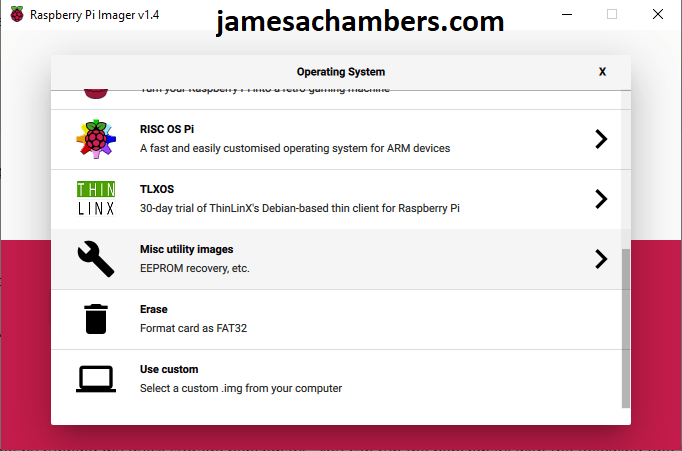
Next choose the “Bootloader (restore the factory default settings and change boot priority)” option:
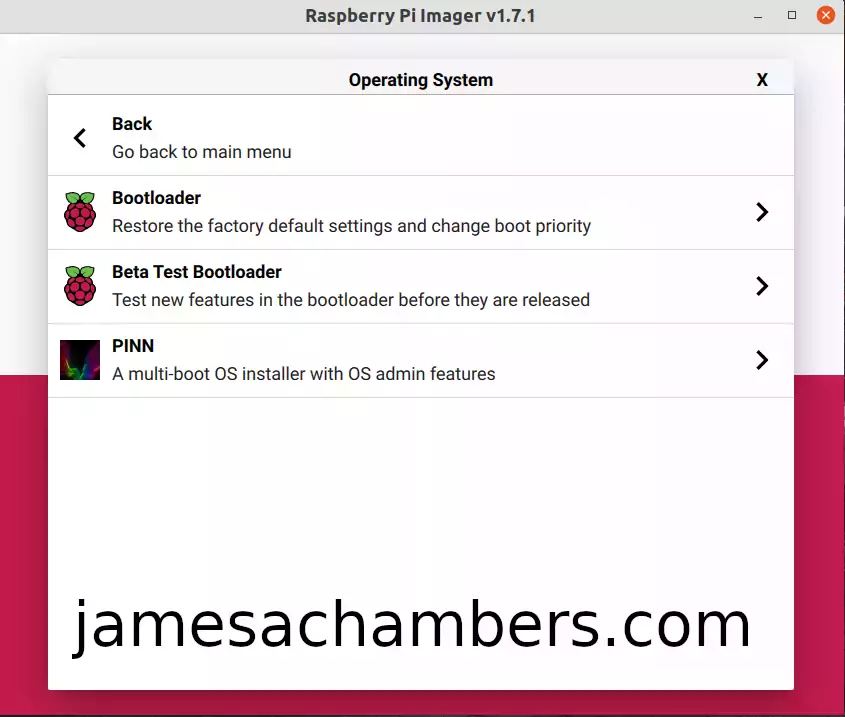
This will take you to a menu where you will select the default boot device for your Raspberry Pi like this:
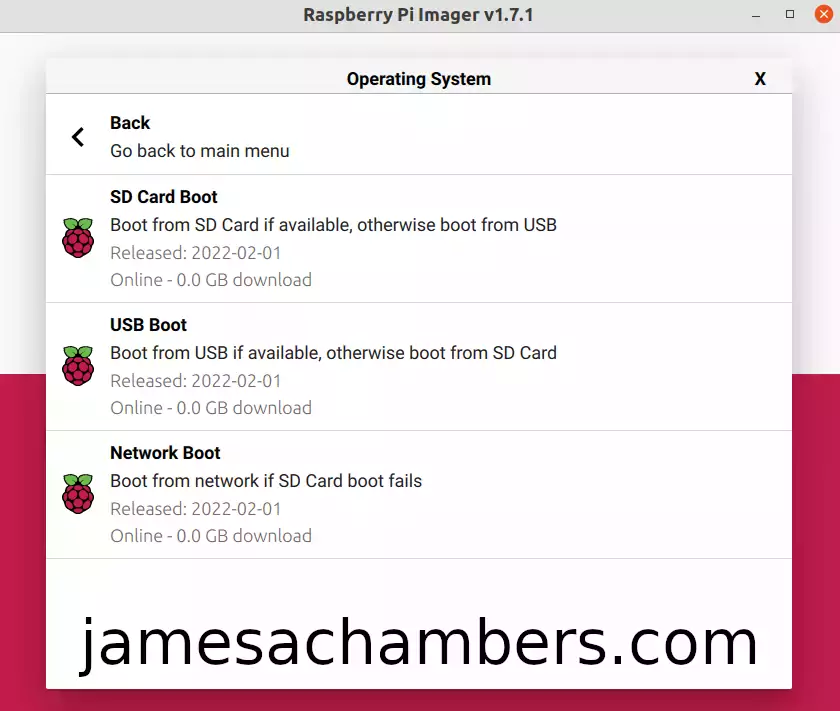
Notice that you are mostly just selecting the primary boot device. Modern versions of the firmware will fall back if the primary boot device fails. The first menu for example says “Boot from SD card if available, otherwise boot from USB”.
This means that if you took the SD card out you could still boot from a USB mass storage device if you selected the first option. Choosing the USB option would work similarly where if the USB mass storage boot failed it would fall back to booting from the SD card. Select the mode you would like and it should take you back to the main menu screen to pick the storage device to write to.
Next choose your SD card and then choose “Write”. Now unplug your Pi and put in the newly prepared SD card. Connect the power and let it boot. This will restore your bootloader to defaults. You should see a continuous rapid green blinking light. You may now disconnect the power and put your original SD card back / reinstall Raspberry Pi OS and boot the Pi normally!
When to Attempt Recovery
There is a simple procedure to tell if your bootloader is corrupt. Turn off your Pi completely and remove the SD card / all attached storage. Now plug your Pi back in with no storage media in it.
If your Pi’s bootloader is healthy you will see the green light blink a few times and then enter a pattern where it will blink 4 times and then have a long pause. It will repeat these 4 blinks / pause in an endless loop.
If your Pi’s bootloader is NOT healthy the green light will not blink. If this is the case it is time to do a bootloader recovery!
Another situation that can warrant a bootloader recovery is when your bootloader is missing a bunch of settings despite being up to date. For example other readers have seen cases where despite having the latest firmware according to rpi-eeprom-update they are missing key settings like the BOOT_ORDER setting. If anything is unusual with your settings many commenters have had success with this method when nothing else worked!
Recovery Procedure
Before powering up your device insert the “recovery” SD card that we made earlier in the requirements section above and make sure that all USB devices are removed. Even keyboards have been known to cause issues so make sure absolutely everything is unplugged!
Now insert the SD card into the Pi and connect the power.
If the bootloader recovery is successful the green activity light will start blinking rapidly continuously (forever). In this case you have successfully recovered your bootloader! You may now insert a normal fully imaged SD card and it will boot normally again.
If anything other than a continuous rapidly blinking green light happens the recovery was not successful.
If Recovery Doesn’t Work
- Try with a freshly imaged Raspberry Pi OS SD card. Sometimes there are unexpected things going on with an image that can prevent the newer firmware from being used (see next bullet point for example).
- Check your “boot” partition of your main OS and make sure there isn’t a file in there called “recovery.bin”. If this file is present it will load that version of the bootloader firmware instead of what is flashed on your Pi. This file should only be present on the “recovery” SD card we created but people are finding these files on their main OS “boot” partition. It’s worth checking to make sure it is not on the main OS SD card / drive you are trying to boot with.
- There is a known (and strange) issue with Raspberry Pi 4’s and 32 GB SD cards where the Pi will abort the boot. If this might apply to you then read this post.
- Make sure you created your SD card correctly. A common pitfall is using cards above 32 GB and formatting them with ex-FAT instead of regular FAT/FAT32.
- Make sure *all* USB devices are unplugged from the Pi
- Try a different SD card if you have one available. SD cards do go bad all the time. If there’s any doubt here check out my Raspberry Pi storage benchmarks page to see the highest performing SD cards (you definitely want an A1+ rated one).
- Check your power cord. Make sure you are using a high quality USB-C power cord that is compatible with the Pi. Even if it was working before I have had several old Pi power supplies that worked for years die on me. If there’s any doubt grab a known reliable one like the Canakit USB-C Raspberry Pi 4 Power Supply*
If you’ve gone through all the steps and are positive it’s not one of the above “gotcha” issues then it’s time to go deeper. You need to observe your Pi’s exact behavior when you plug it in (what the lights are doing). Here is a table of different blink patterns and what they mean:
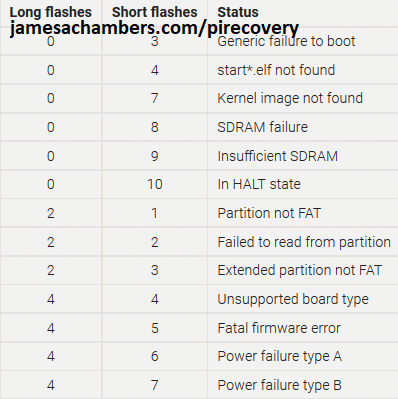
If your Pi’s LED behavior matches any of these codes then we now have much more to go on to diagnose why your Pi won’t boot. Some of them are very obvious but they’re all worth a quick web search once you have matched it to a code.
If your Pi’s behavior does not match one of these codes head to the official sticky post on the Raspberry Pi forums and scroll to the very bottom (post #4 specifically for Raspberry Pi). This tracks ongoing boot issues with the Pi 4 that may affect your Pi and a whole bunch of things to try. If you get through that post go all the way up to post #1 and start going down the list.
Could My Pi Be Dead?
It’s absolutely possible. Things like power issues (surges etc), wiring breadboards incorrectly, etc. can kill your Pi completely. That being said, if you have a Pi 4 that appears to be dead and you’ve gone through all my troubleshooting steps / the official sticky post / you aren’t covered by warranty then I would hold onto it for now as it’s still very new and some problems are still being investigated with the bootloader.
I have definitely killed a couple myself. I had a 3B+ that I had been using for a year building images (basically beating the crap out of it) on that finally had a hardware failure and would no longer boot. I wasn’t too sad about this one because I absolutely beat the crud out of these devices and push them to the absolute limit.
My more heartbreaking one was that I have killed a 4 GB Pi 4 that I got right at the Pi 4’s launch. I left this Pi in a very hot area running an experimental image that didn’t have proper firmware on it for about 2.5 weeks and now upon powering it up the green light will start blinking like it’s about to start booting then the green light will freeze and stay stuck on forever. I have a couple other Pi 4’s so I know all my cards and power supplies are good.
Make sure you’ve reviewed the official sticky post I linked in the previous section before jumping to this conclusion though. These things are not fragile and over all the years of running this blog it’s pretty amazing I’ve only killed 2 of them with the insane things I try on them all the time.
I may be able to help if you want to leave a comment here with *exactly* what behavior you’re seeing when you try these procedures, when you plug it in with no SD card in it, when you plug it in with a SD card in it, any little details will help!
Other Resources
For headless configuration of your Raspberry Pi using the Pi Imager
If you’re trying to setup USB mass storage booting (like with a SSD) check out my Raspberry Pi 4 Native USB Booting Guide
If you want to see which Pi storage performs the fastest and get an idea of what kind of drives to look for check out my 2020’s Fastest Raspberry Pi 4 Storage Benchmarks
If you have one of the new Raspberry Pi 400 kits *then don’t miss my Pi 400 Overclocking and SSD Setup Guide



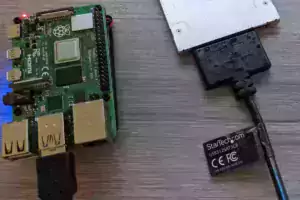

I updated the bootloader of my Pi4 according to this tutorial. It was still on 13701 (May 10, 2019).
After „sudo reboot“ the Pi didn‘t boot anymore. 🙁 I successfully fixed the bootloader with the recovery method but unfortunately my former SD card won‘t boot anymore. So my whole system is broken. I‘m using the Pi as DHCP server, DNS (Pihole) and I had lots of services running there (UniFi Controller, tvheadend server, python scripts etc.).
Never change a running system. ;(
I don‘t even have a micro-HDMI adapter since I forgot to order it and never needed it until today. The Pi4 was running headless for months without a problem. So without SSH access I‘m basically „blind“ and have no idea what‘s going on.
Be careful and make sure to have a recent backup!
Just use “pi card manager” on your cellphone. Free for android
Works fine in Libreelec too (check and update, no apt install required), guess the 18.5 Kodi packagers were aware. Thx for the original post, I had no idea that it had an on-board firmware image now
Found that someone cannot update the firmware because they(I) are using SSD as system boot clone from SD card. After I change the /boot/cmdline.txt to the original and boot from SD card, apt-get full-upgrade and rpi-eeprom-update -a with reboot, the firmware update success. Then I change the cmdline.txt back to reboot SSD and check rpi-eeprom-update, it will said firmware is up-to-date.
I am strugling with probably this issue. What is difference betwwen rpi-eeprom-update and rpi-update? Uname -a shows me and old firmware eventhough updated on both ssd and sd card. This is why I probably need to update the firmware.
The bootloader (and associated firmware) actually reduce the power consumption of both the USB controller and core SoC, with the USB controller accounting for about half the power saving. Even the most USB-heavy use cases see some benefit from ASPM (ASPM = Active-State Power Management).
Is there any special precautions to take into account if you are using the an SDD for the root partition? I followed the guide to do it from this site.
Hey James,
Not really anything special. I would just make sure that every once in a while you insert a Raspbian image and run the bootloader updater.
Will it be possible to use rpi-eeprom from an OS other than Raspbian at any point in the future do you know?
Hey Tommy,
The utility is open source so it’s not closed source or a precompiled binary or anything. Looking at the source code you would need to have very up to date Raspberry Pi userland tools (this one uses vcmailbox and dtparam). Here’s the code for the main update part:
if [ -f "${BOOTLOADER_UPDATE_IMAGE}" ]; then# Bootloader EEPROM chip-select is muxed with audio pin so disable audio
# LDO first to avoid sending noise to analog audio.
"${VCMAILBOX}" 0x00030056 4 4 0 > /dev/null || true
dtparam audio=off
# Switch the SPI pins to boot EEPROM
dtoverlay spi-gpio40-45
modprobe spidev
modprobe spi-bcm2835
prepareImage "${BOOTLOADER_UPDATE_IMAGE}"
echo "Applying bootloaer update ${BOOTLOADER_UPDATE_IMAGE}"
flashrom -p "linux_spi:dev=/dev/spidev0.0,spispeed=${SPI_SPEED}" -w "${TMP_EEPROM_IMAGE}" || die "flashrom EEPROM update failed"
dtparam -R spi-gpio40-45
dtparam audio=on
${VCMAILBOX} 0x00030056 4 4 1 > /dev/null || true
fi
I personally haven’t tried it since I have already bricked one 4 GB Pi 4 since launch which has lowered my appetite for trying this. That may change some day as I continue to get more adventurous
Since there aren’t a lot of distributions that have up to date userland tools like vcmailbox it would be inadvisable to to try it if the code I pasted above makes you uncomfortable. For my Ubuntu 18.04.3 image I build the very latest userland tools every update so I know they are up to date in there but it looks like you also need to have working spidev and several other kernel modules so even with the latest tools on mine there’s a bunch of things I’d have to double check.
So the final answer would be: probably in time this will appear in some other distributions!
The latest userland tools are all that is necessary to utilize rpi-eeprom-update. You do not need the latest spidev or any other kernel modules in order to update. The default and recommended method which rpi-eeprom-update uses is to copy recovery.bin, pieeprom.upd and vl805.bin along with signature files for each to the boot partition. Upon reboot the Pi’s bootloader will load and execute recovery.bin which then flashes the update files after checking that they match the signatures in signature files to prevent flashing corrupt firmware files. recovery.bin is then renamed to recovery.000 to prevent it form executing the next time the Pi is rebooted.
I have successfully updated multiple Pi’s without incident under Ubuntu.
Hey Tim,
You’re right, in fact you can even install the native utilities in Ubuntu now with sudo apt install rpi-eeprom. This is a very new thing though. Ubuntu 18.04 wasn’t even officially supported on the Pi. This is a benefit that has come with official support!
I understand on a technical level that all we’re doing is flashing a small firmware file to an EEPROM chip and that kernel support isn’t required or anything like that. In fact, the rpi-eeprom tool is available on GitHub and you have been able to use it on any other OS this whole time.
I still wouldn’t recommend doing it personally. People are having a lot of problems with the firmware and bootloader throughout this post as well as my USB booting guide posts. This is sometimes even using the latest Raspberry Pi OS. If you’re someone like Tim or myself who have multiple Pis, and I can only speak for myself here but personally I am willing to accept the possibility of bricking them, then by all means these tools are available.
I’m seeing enough problems with firmware updates in general that I would probably wait a good year or two before messing with the firmware tools too much on Ubuntu unless you are really comfortable with this stuff. Let people like us take the hit and report the problems we’re seeing and get them fixed for everyone else! Tim has has good luck so far, but not everyone has.
My recommendation still at this time is for ordinary users who just need to update/restore their firmware is to use the official Raspberry Pi OS. There are still lots of things going wrong and the Pi 4 is the first one with firmware that can be updated like this. Stick with the official method for now!
Is it safe to be using the server (CLI-only) version of Raspbian to perform this update?
Yes, Raspbian Lite is safe!